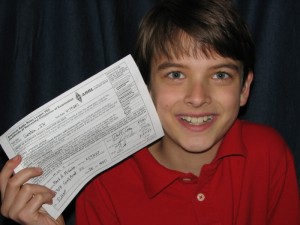All I remember about decided to study for my amateur radio test, is sitting on the couch, reading a library book. The book was the ham radio one, I don’t quite remember why it made me excited, but I do remember starting the class the beginning of May.
How I learned about my test was reading the radio book, and writing down the answers–I am surprised I did not get writers cramp because I was part of a class. (Grandpa offered to take me to the class and got the book for me). I think there were 5 people besides me in class. all of them where older.
The class itself was tell the answers of the questions that were asked in a notebook that the teacher gave me. I thought for the homework if I didn’t have Momma to help me, I would DEFINITELY get writers cramp. I just read the book if we didn’t do the homework. I could answer most of the questions by memory when the teacher asked the questions.
The test was sort of easy once I understood what it would be like. The real test was different than the practice tests I got at home. It was set up differently and the orange paper threw me off the most.
I was really nervous taking my test, so thank you for praying for me. It helped me a lot.
I did not pass it on the first try. When I did not pass it on the first try I felt bad. I missed it by one–which made matters worse. I knew I could retake it then but I still felt sad.
The second time I passed it and then I tried the General Class test. I got half of the General questions right. It was not enough to pass. But I did better than Momma!
Now I am waiting for my call sign. It’s kind of like my name and it helps identify where you got your license from, but not where you are.
Depending if I use a base station or a hand held radio, I can talk around the world on the radio!
Here are three of the questions I needed to know. Do you know the answers to them?
🙂
What is the term used to describe opposition to current flow in ordinary conductors such as wires?
A. Inductance
B. Resistance
C. Counter EMF
D. Magnetism
8)
What formula is used to calculate resistance in a circuit?
A. Resistance (R) equals voltage (E) multiplied by current (I)
B. Resistance (R) equals voltage (E) divided by current (I)
C. Resistance (R) equals voltage (E) added to current (I)
D. Resistance (R) equals voltage (E) minus current (I)
😉
What is the resistance of a circuit when a current of 3 amperes flows through a resistor connected to 90 volts?
A. 3 ohms
B. 30 ohms
C. 93 ohms
D. 270 ohms






